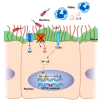The Multifaceted Roles of MicroRNAs in Cystic Fibrosis
- PMID: 33348555
- PMCID: PMC7765910
- DOI: 10.3390/diagnostics10121102
The Multifaceted Roles of MicroRNAs in Cystic Fibrosis
Abstract
Cystic fibrosis (CF) is a lifelong disorder affecting 1 in 3500 live births worldwide. It is a monogenetic autosomal recessive disease caused by loss-of-function mutations in the gene encoding the chloride channel cystic fibrosis transmembrane conductance regulator (CFTR), the impairment of which leads to ionic disequilibria in exocrine organs. This translates into a chronic multisystemic disease characterized by airway obstruction, respiratory infections, and pancreatic insufficiency as well as hepatobiliary and gastrointestinal dysfunction. Molecular characterization of the mutational heterogeneity of CFTR (affected by more than 2000 variants) improved the understanding and management of CF. However, these CFTR variants are linked to different clinical manifestations and phenotypes, and they affect response to treatments. Expanding evidence suggests that multisystemic disease affects CF pathology via impairing either CFTR or proteins regulated by CFTR. Thus, altering the expression of miRNAs in vivo could constitute an appealing strategy for developing new CF therapies. In this review, we will first describe the pathophysiology and clinical management of CF. Then, we will summarize the current knowledge on altered miRNAs in CF patients, with a focus on the miRNAs involved in the deregulation of CFTR and in the modulation of inflammation. We will highlight recent findings on the potential utility of measuring circulating miRNAs in CF as diagnostic, prognostic, and predictive biomarkers. Finally, we will provide an overview on potential miRNA-based therapeutic approaches.
Keywords: antagomiRs; antimiRs; biomarkers; circulating miRNAs; cystic fibrosis; genetic disease; miRNA mimics; microRNA; microRNA-targeted therapies.
Conflict of interest statement
V.R. and G.K. are listed as inventors on a patent application (No. 13/895741) describing the use of cysteamine for the treatment of CF. The authors declare no conflict of interest.
Figures

References
Publication types
LinkOut - more resources
Full Text Sources

